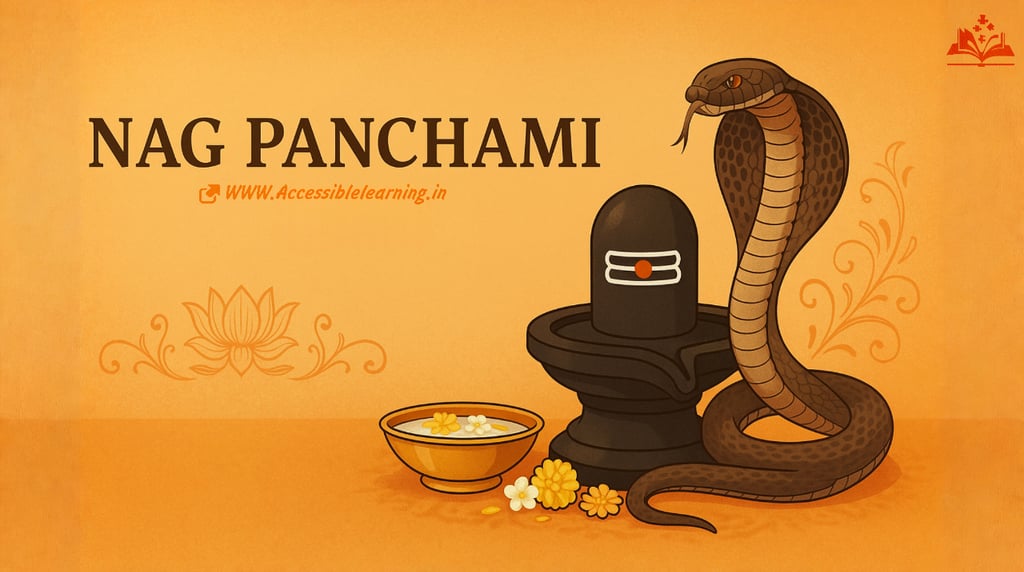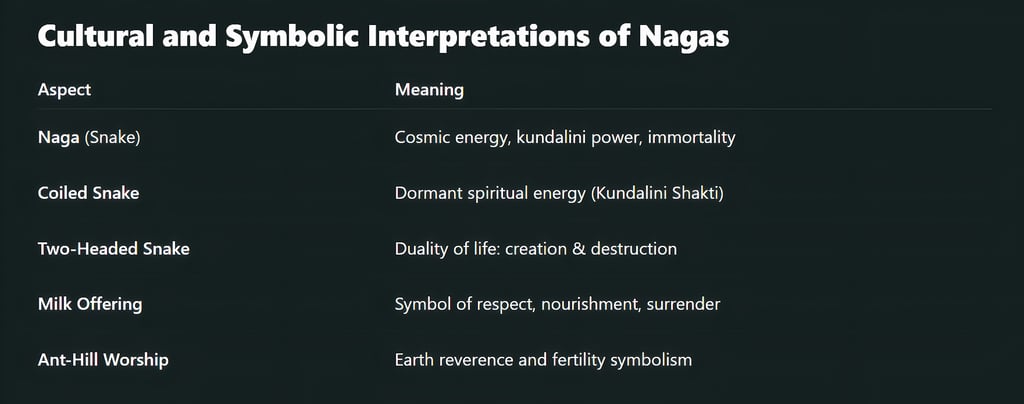
Nag Panchami 2025: Date, Significance, Rituals & Symbolism of India’s Sacred Snake Festival
Discover the spiritual essence of Nag Panchami 2025—the sacred Hindu festival of snake worship. Explore its date, significance, rituals, regional customs, and symbolism across India.
CULTURE/TRADITIONINDIA/BHARATCELEBRATION/FESTIVALSEDUCATION/KNOWLEDGE
Sachin K Chaurasiya
7/24/20255 min read


Nag Panchami is one of India’s most ancient and revered festivals dedicated to the worship of serpents (nagas). Celebrated on the fifth day (Panchami) of the bright half of the lunar month of Shravana (July–August), this day marks deep spiritual symbolism, cultural unity, and ecological awareness.
Snakes, often misunderstood, are honored as guardians of fertility, rain, and cosmic energy in Hindu tradition. Nag Panchami is not just a religious observance—it is a vibrant blend of mythology, nature reverence, and regional customs.
Nag Panchami 2025 Date & Muhurat
Date: Monday, August 4, 2025
Panchami Tithi Begins: 03:35 PM on August 3, 2025
Panchami Tithi Ends: 01:58 PM on August 4, 2025
Nag Panchami Puja Muhurat: 06:00 AM to 08:30 AM (Varies by region)
Why is Nag Panchami Celebrated?—The Spiritual & Cultural Significance
Symbol of Protection and Fertility
Nagas are believed to guard earth’s treasures and water bodies. Worshiping them is a prayer for rain, fertility of crops, and shielding families from evil or misfortune.Ecological Message
The festival promotes snake conservation, urging people not to harm these essential creatures, as they maintain ecological balance by controlling pests.Mythological Relevance
Mahabharata Connection: A popular story tells of Janamejaya performing a snake sacrifice (Sarpa Satra) to avenge his father’s death, stopped only due to the intervention of sage Astika on Panchami day.
Shiv’s Vahana: Snakes are closely associated with Shiva, as Vasuki (a cobra) adorns his neck.
Krishna’s Kaliya Mardan: On this day, Lord Krishna subdued Kaliya, a venomous serpent polluting the Yamuna.
How is Nag Panchami Celebrated Across India?
Rituals & Puja Vidhi
Preparation: Devotees wake early, bathe, clean the house, and prepare offerings.
Idol Worship: Images of Nag Devtas made from clay, silver, or painted on walls are worshipped.
Offerings: Milk, turmeric, rice, durva grass, flowers, and sweets like laddoos are offered to snake deities.
Fasting: Many observe a Nag Panchami vrat (fast) and avoid digging the ground, believing it may harm snakes beneath the surface.
Mantras: Chanting the Nag Stotra and Sarpa Suktam is common for invoking protection and peace.
Unique Regional Celebrations
Maharashtra: Women visit ant-hills or snake pits and offer milk; fairs and snake charmers participate in rural areas.
South India: Temples like Mannarasala in Kerala conduct special serpent rituals; turmeric, flowers, and milk adorn sacred groves (Sarpakavu).
North India: In Uttar Pradesh and Bihar, live snakes (usually de-venomed) are worshipped.
Karnataka: Nag Panchami is one of the main festivals in parts of coastal Karnataka, celebrated with Naga Mandala and Yakshagana performances.



The Role of Women in Nag Panchami
Nag Panchami is often considered a women-centric festival, especially in rural regions:
Women pray for the well-being of their brothers and children.
Newly married women observe special vrats (fasts) and perform rituals for a harmonious marital life.
In some states, like Maharashtra and Madhya Pradesh, brides are gifted new clothes or jewelry on this day.
Connection with Astrology and Rahu-Ketu
Snakes are associated with the shadow planets Rahu and Ketu, which influence Kaal Sarp Dosh in Vedic astrology.
Performing Nag Panchami puja is believed to neutralize astrological afflictions caused by these planets.
People suffering from Kaal Sarp Dosh often perform special pujas in temples like Trimbakeshwar (Nashik) or Mahakaleshwar (Ujjain) on this day.
Notable Temples and Pilgrimage Sites for Nag Panchami
These temples hold grand celebrations and special rituals.
Mannarasala Temple, Kerala—Presiding over 30,000 serpent idols, it's the most iconic serpent temple in India.
Nagchandreshwar Temple, Ujjain—Open to devotees only on Nag Panchami.
Ghati Subramanya, Karnataka—Devoted to Subramanya Ji and serpents.
Baba Dhansar, Jammu—A sacred cave associated with Nagas and spiritual legends.
FAQs
Q. Is Nag Panchami related to Shiv?
Yes. Shiv Ji is often depicted with a snake (Vasuki) coiled around his neck. Snakes are seen as his divine companions, and worshiping them is akin to honoring Shiv.
Q. Why is milk offered to snakes on Nag Panchami?
Traditionally, milk symbolizes purity, surrender, and nourishment. It is believed to pacify snake deities. However, wildlife experts now promote symbolic offerings or eco-friendly rituals instead of using live snakes.
Q. What should we not do on Nag Panchami?
Avoid these practices:
Digging soil (may hurt hidden snakes or insects)
Ploughing fields
Killing or harming snakes
Consuming non-vegetarian food (as the day emphasizes non-violence and harmony with nature)
Q. How does Nag Panchami help in reducing Kaal Sarp Dosh?
Performing Nag Puja, mantra chanting, and visiting serpent temples on Nag Panchami is said to pacify the effects of Kaal Sarp Dosh in one's horoscope, leading to peace and prosperity.
Q. Are there any specific mantras chanted on Nag Panchami?
Yes, here’s one common mantra:
"Om Kurukulye Hum Phat Swaha"
Also, devotees recite the Nag Panchami Vrat Katha and mantras like
"Ananta Vasuki Shesha Padmanabha Cha Kambala
Shankhapala, Dhritarashtra, Takshaka, Kaliya"
These are the eight major serpent gods worshiped on this day.
Q. Can Nag Panchami be celebrated at home?
Absolutely. Even without temple visits, people
Draw snake symbols near their doors
Offer turmeric, flowers, and milk
Recite Nag Panchami stories and mantras
Keep a clean, sacred corner for the puja
Q. Is Nag Panchami celebrated outside India?
Yes, especially in Nepal, where Nag Pokhari in Kathmandu hosts huge gatherings. It is also observed in communities of Hindu diaspora in Mauritius, Bali (Indonesia), and parts of Sri Lanka.


Folk Songs & Cultural Expressions
In several regions, women sing Nag Geet (folk songs for serpents) while making symbolic offerings at homes or ant-hills:
These songs praise Nag Devta and seek protection from venomous bites and family crises.
Local dances, fairs, and snake-themed art are also showcased.
Nag Panchami & Scientific Outlook
Though modern science discourages offering milk to snakes (as they are not milk-drinkers), many temples now symbolically pour milk or donate it to the poor.
It’s also a reminder to co-exist with wildlife—educating people about the ecological importance of snakes is a growing part of the festival.
Nag Panchami in Modern Times: Evolution & Awareness
Today, Nag Panchami has taken a more symbolic and conservation-friendly turn, with wildlife organizations using it as an opportunity to:
Educate villagers on non-venomous vs. venomous snakes
Rescue snakes from exploitation during festivals
Encourage use of images or idols instead of real snakes
It’s a festival where myth meets mindfulness and tradition meets transformation.
In a world increasingly detached from nature, Nag Panchami revives ancient respect for all life forms. It blends spiritual reverence, nature conservation, and cultural storytelling, reminding us that divinity exists not just in temples, but also in the forests, rivers, and under the soil.
By honoring serpents, we honor the cycle of life, death, and rebirth, and reaffirm our connection with nature’s primal forces.
Subscribe To Our Newsletter
All © Copyright reserved by Accessible-Learning Hub
| Terms & Conditions
Knowledge is power. Learn with Us. 📚


